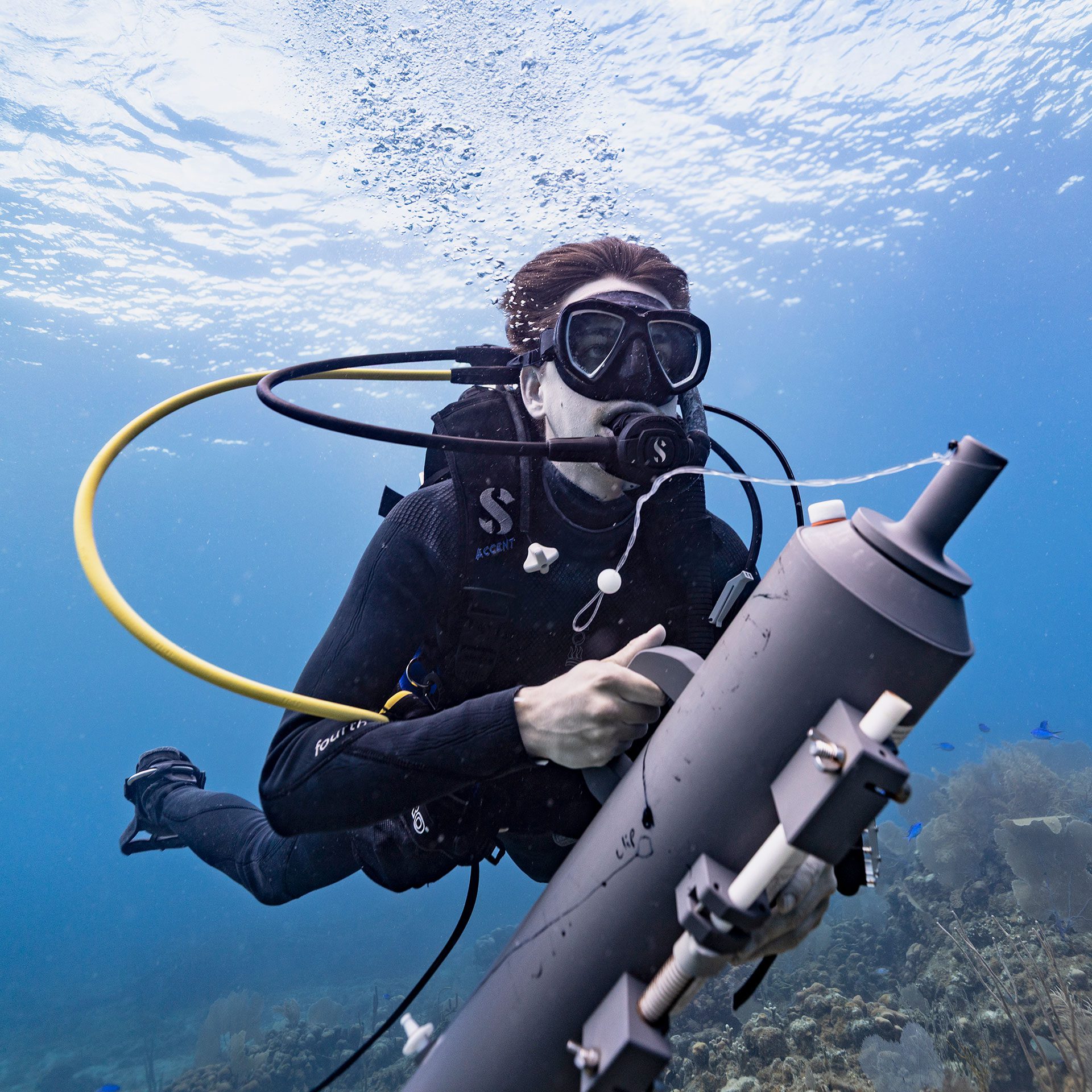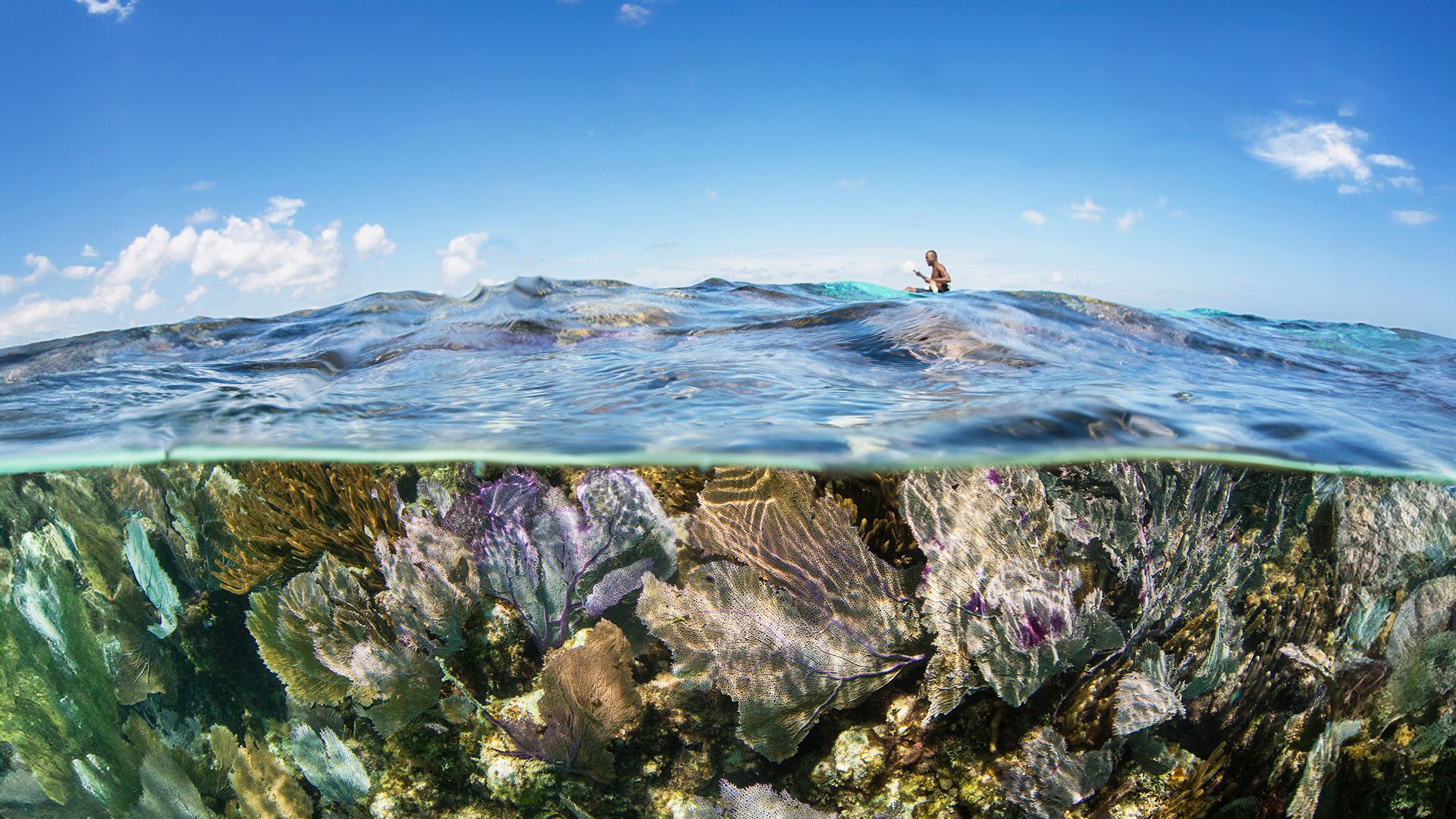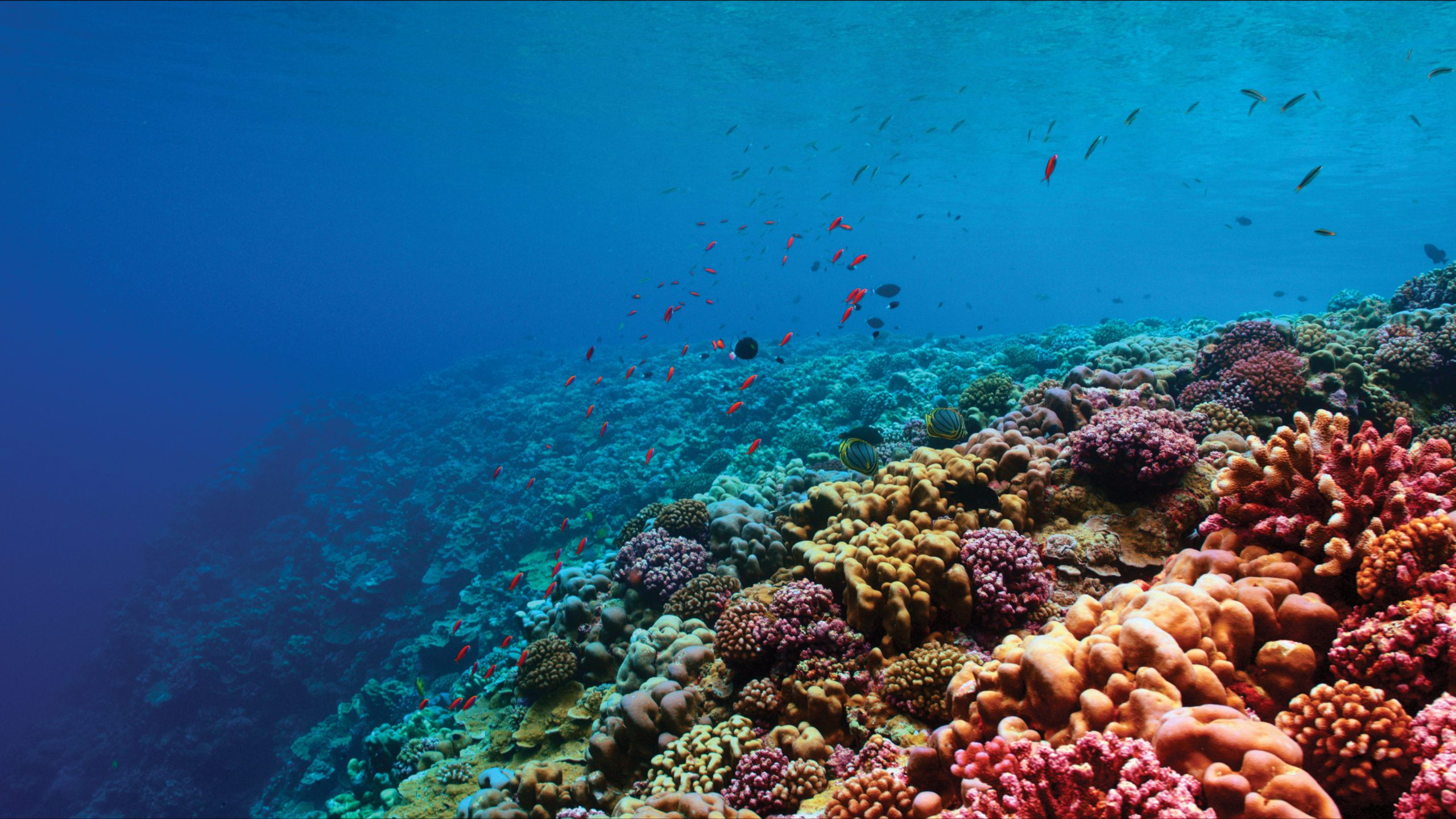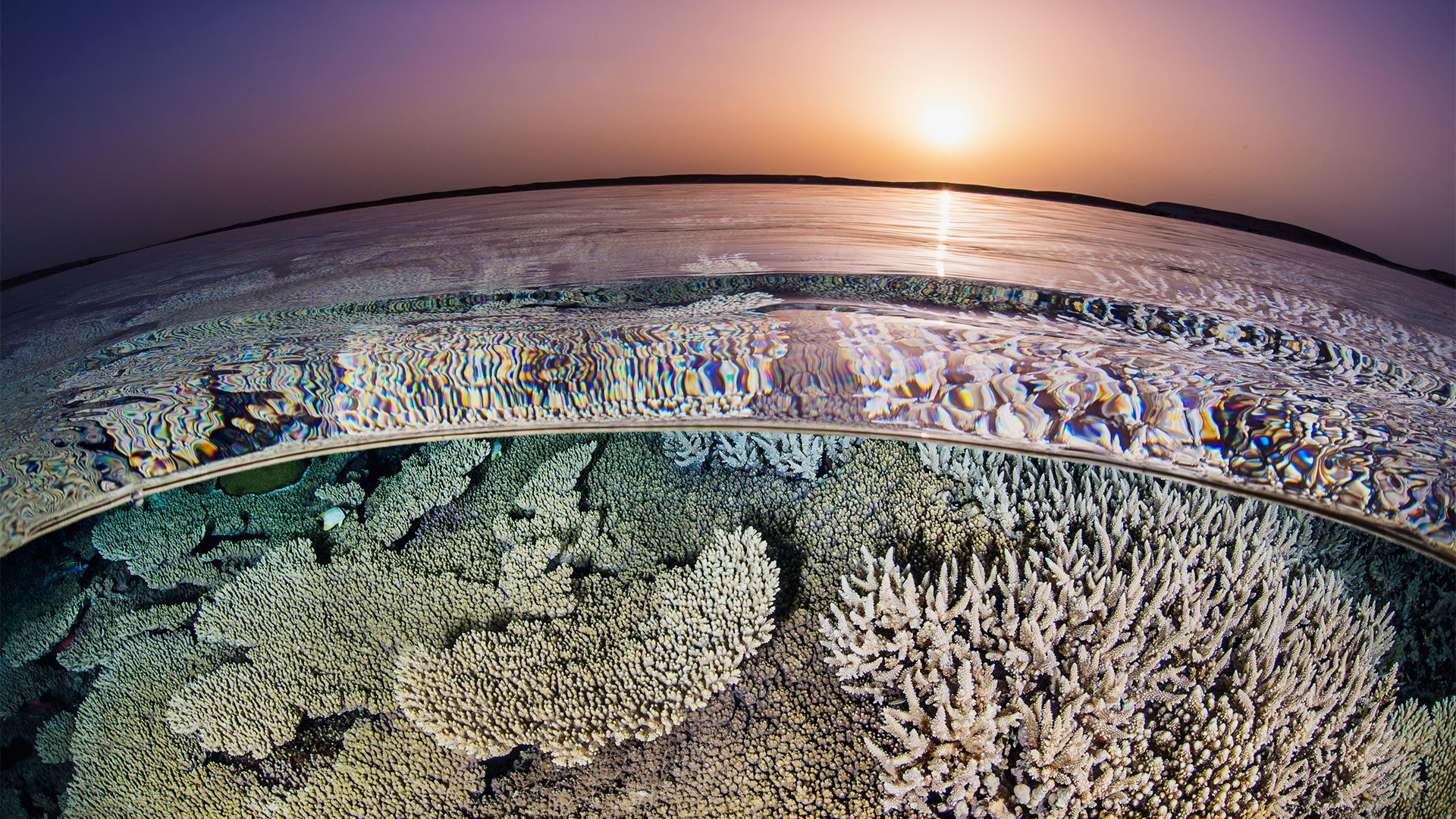
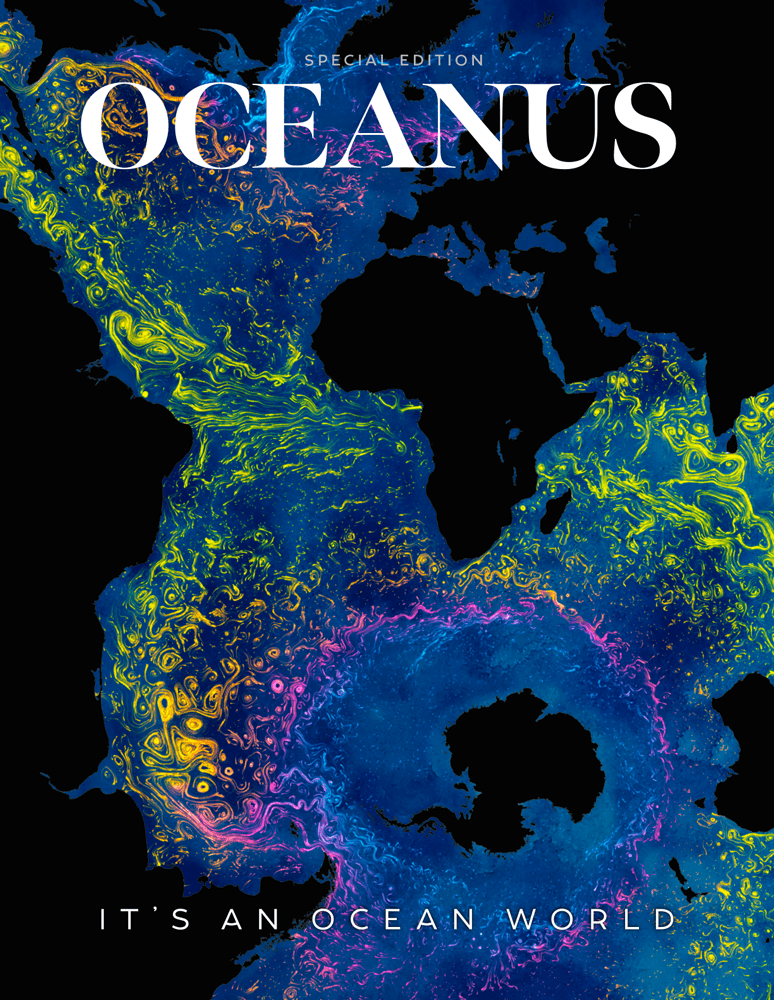 This article printed in Oceanus Winter 2025 - SPECIAL ISSUE
This article printed in Oceanus Winter 2025 - SPECIAL ISSUE
Estimated reading time: 6 minutes
As coral reefs fade in the face of environmental stressors, the Reef Solutions Initiative team at WHOI is racing against time to find better ways to protect these essential marine ecosystems. The plan is to examine reef health, determine likely causes of stress, and address them when possible. Similar to a human wellness exam, the new protocol investigates reef health to catch problems before they become too serious to treat.
Coral reefs face an onslaught of stressors, including marine heat waves, sediment buildup from coastal activities, and runoff from sewage and fertilizers. Motors drown out the soundscape of a healthy reef, blocking communication among reef organisms and preventing new corals from settling. Overfishing removes the grazers that stop macroalgae from taking over the reef.
And then there’s disease. A variety of coral diseases have become prevalent in recent years, but the most damaging is stony coral tissue loss disease (SCTLD). A 2014 dredging event likely “introduced novel pathogens, which have spread throughout the Caribbean,” says WHOI microbial ecologist Amy Apprill. Over the last decade, SCTLD has killed corals representing a third of Caribbean species.
Due to these combined stressors, many Caribbean reefs have lost more than 90 percent of their essential reef-building corals in recent decades. When corals die, other animals leave in search of better habitat. Those unable to relocate die as the reef ecosystem begins to break down. The key is to stop the downward spiral when it starts, and that’s where the Reef Solutions Initiative comes in.
A deeper look at reef health
Imagine if a visit to the doctor involved only an external examination. No blood draw, no stethoscope, no in-depth look at what’s happening inside the body. Up to now, that’s how people have assessed the health of coral reefs. Assessments have relied on visual changes: bleaching as stressed corals eject their symbiotic algae, lesions appearing as corals succumb to disease, or the steady march of macroalgae as they take over a reef.
But once those signs become evident, corals and other reef inhabitants are already in serious trouble. The Reef Solutions Initiative aims to take a more in-depth look at reef health, monitoring reefs for early signs of stress so problems can be addressed before coral loss becomes an issue. That requires a cross-disciplinary approach that incorporates information on microorganisms, water quality, community metabolism, coral recruitment, hydrodynamics, fish behavior, and more.
Apprill is monitoring reefs for tiny microbes to learn how their numbers and community composition reflect reef health. Some microbes thrive in healthy reefs. The presence of others indicates the reef is struggling, often due to land-based pollution. “What I’m working towards is a suite of indicator microbes that we can rapidly test for, almost like a COVID test,” she says. “Then you can take a water sample and quickly understand whether those specific microbes are in the water.”
When land-based pollution isn’t the problem, Apprill is developing probiotics to help boost reef health. “There are certain coral species that are more resilient to [SCTLD], and they have certain components of their microbial communities that may make them more resistant to disease,” says University of the Virgin Islands collaborator and coral reef ecologist Marilyn Brandt. If the team can harness those beneficial microbes, she says, “that could turn the tide against disease.”
The microbial array is one of a suite of diagnostic tools the Reef Solutions Initiative team is developing. Reef respiration sensors will detect when oxygen levels get out of balance. A different set of sensors will monitor corals for reactive oxygen species, short-lived chemicals released during times of stress. An array of hydrophones — microphones designed for underwater use — can detect changes to the reef soundscape. A thriving reef abounds with the snaps, grunts, and groans of its inhabitants, but a dead reef lacks those fish sounds and can be eerily silent. A shifting soundscape can signal a struggling reef.
The ultimate goal is for reef managers and other stakeholders to deploy the newly developed sensors across their reefs. The sensors will send alerts when they detect early signs of stress, giving stakeholders time to diagnose and treat the problem.
Building a better reef
Brandt is actively involved in reef restoration in the U.S. Virgin Islands, where she rears healthy corals in a nursery and outplants them when they’re big enough to survive. The question then is: What’s the best location for these new corals? If the reef has been badly damaged by runoff, sediment, or high temperatures, it may no longer be an ideal spot for reef-building coral colonies. That’s where Weifeng (Gordon) Zhang’s work comes in.
Zhang studies hydrodynamics — movement of water — to understand how conditions change over small areas along a reef. “Basically,” he says, “I study underwater weather for the corals.” Through his computer models, he’s found that those underwater weather conditions are highly variable, even along a single reef.
“The corals [that] live on one side of the island and the corals on the other side of the island, they actually experience very different environmental conditions,” he says. Those variations affect corals in a variety of ways, from water temperature to nutrient availability to salinity. The Reef Solutions Initiative team plans to use Zhang’s models to better understand which sites make the best places to rebuild reefs.
“People are spending all this effort trying to rebuild the coral reefs,” he says. “But you probably don’t want to rebuild [in] a place that is going to experience sustained heat waves.” The models can help identify better locations where reef restoration efforts will be more likely to succeed.
When Zhang’s models suggest building a reef in an entirely new location, WHOI biologist Aran Mooney uses recordings of healthy reefs to attract new corals to the area. Most of a healthy reef’s soundscape comes from fish. Even though fish get less attention than coral, “they’re definitely part of that circle of life there and needed. They’re the ones that make the sounds that we think attract the coral larvae,” he says. Playing recordings of healthy reefs encourages them to settle and grow into new colonies.
“We’re trying to encourage them to go to a place that we think they’ll succeed [in],” Mooney says. The reef may not be thriving and healthy—yet. The goal is to use the new suite of tools to help the reef become fully functional and self-sustaining.
Once the restoration effort gets underway, Collen Hansel’s work aims to give the new corals a boost with the reef equivalent of a multivitamin. Corals “are the rainforest of the sea, but they live in the deserts of the sea,” she says. “When they start to get stressed, they don’t have reserves of nutrients in the water to use to boost their immune system.” Hansel’s lab is engineering a variety of substrates that slowly release a range of essential nutrients and vitamins into the water, where corals can access them when needed.
Coral fragments raised in nurseries can be outplanted on Hansel’s nourishing substrates to boost their survival rates. The same is true for coral larvae that settle on nutrient-rich surfaces. But Hansel’s team is going further, developing a variety of methods to bring those slow-release vitamins to intact reefs, too, to help them cope with early stages of stress. These methods involve all-natural mineral-based paints to cover large areas and small tiles that can be placed at strategic points along degraded or artificial reefs. Both gradually release nutrients that will boost the corals’ growth and immune response.
The ultimate goal of the Reef Solutions Initiative team is to make their innovations available to people around the world. How quickly that happens depends in part on funding for the large, collaborative project. “When you put it all together,” Hansel says, “hopefully we can do something in terms of helping restore and protect and conserve the corals and all of the life that depends on them.” There’s not a moment to waste.
Advanced Diagnostics
- Monitor coral health
- Determine water quality
- Examine chemical + microbial signs of stress
Robotics
- Map coral cover + condition
- Collect biodiversity + invasive species data
- Early warning system for bleaching
Bioacoustics
- Attract coral larvae
- Sound-based health diagnostics
- Understand fisheries+ ecosystem health
Health Interventions
- Coral probiotics
- Vitamin supplements
- Metabolomics to diagnose+ treat disease
Hydrodynamics
- Map currents + temperature
- Predict coral larval transport + settlement
- Model + forecast environmental changes
- Identify + prioritize restoration sites
